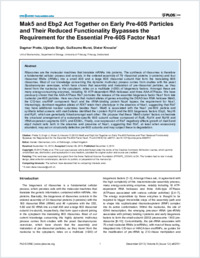Mak5 and Ebp2 act together on early Pre-60S particles and their reduced functionality bypasses the requirement for the essential Pre-60S factor Nsa1
- Pratte, Dagmar Unit of Biochemistry, Department of Biology, University of Fribourg, Switzerland
- Singh, Ujjwala Unit of Biochemistry, Department of Biology, University of Fribourg, Switzerland
- Murat, Guillaume Unit of Biochemistry, Department of Biology, University of Fribourg, Switzerland
- Kressler, Dieter Unit of Biochemistry, Department of Biology, University of Fribourg, Switzerland
-
02.12.2013
Published in:
- PLoS ONE. - 2013, vol. 8, no. 12, p. e82741
English
Ribosomes are the molecular machines that translate mRNAs into proteins. The synthesis of ribosomes is therefore a fundamental cellular process and consists in the ordered assembly of 79 ribosomal proteins (r-proteins) and four ribosomal RNAs (rRNAs) into a small 40S and a large 60S ribosomal subunit that form the translating 80S ribosomes. Most of our knowledge concerning this dynamic multi-step process comes from studies with the yeast Saccharomyces cerevisiae, which have shown that assembly and maturation of pre-ribosomal particles, as they travel from the nucleolus to the cytoplasm, relies on a multitude (>200) of biogenesis factors. Amongst these are many energy-consuming enzymes, including 19 ATP-dependent RNA helicases and three AAA-ATPases. We have previously shown that the AAA-ATPase Rix7 promotes the release of the essential biogenesis factor Nsa1 from late nucleolar pre-60S particles. Here we show that mutant alleles of genes encoding the DEAD-box RNA helicase Mak5, the C/D-box snoRNP component Nop1 and the rRNA-binding protein Nop4 bypass the requirement for Nsa1. Interestingly, dominant-negative alleles of RIX7 retain their phenotype in the absence of Nsa1, suggesting that Rix7 may have additional nuclear substrates besides Nsa1. Mak5 is associated with the Nsa1 pre-60S particle and synthetic lethal screens with mak5 alleles identified the r-protein Rpl14 and the 60S biogenesis factors Ebp2, Nop16 and Rpf1, which are genetically linked amongst each other. We propose that these ’Mak5 cluster’ factors orchestrate the structural arrangement of a eukaryote-specific 60S subunit surface composed of Rpl6, Rpl14 and Rpl16 and rRNA expansion segments ES7L and ES39L. Finally, over-expression of Rix7 negatively affects growth of mak5 and ebp2 mutant cells both in the absence and presence of Nsa1, suggesting that Rix7, at least when excessively abundant, may act on structurally defective pre-60S subunits and may subject these to degradation.
- Faculty
- Faculté des sciences et de médecine
- Department
- Département de Biologie
- Language
-
- English
- Classification
- Biological sciences
- License
-
License undefined
- Identifiers
-
- RERO DOC 209164
- DOI 10.1371/journal.pone.0082741
- Persistent URL
- https://folia.unifr.ch/unifr/documents/303480
Statistics
Document views: 106
File downloads:
- pdf: 179
